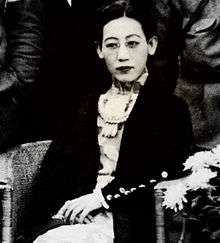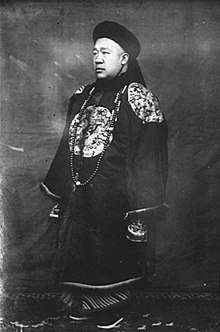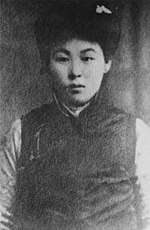Yoshiko Kawashima
Yoshiko Kawashima (川島 芳子, Kawashima Yoshiko, 24 May 1907 – 25 March 1948) was a Qing dynasty princess of Manchu descent. She was raised in Japan and served as a spy for the Japanese Kwantung Army and puppet state of Manchukuo during the Second Sino-Japanese War. She is sometimes known in fiction under the pseudonym "Eastern Mata Hari". After the war, she was captured, tried and executed as a traitor by the Nationalist government of the Republic of China. She was also a notable descendant of Hooge, eldest son of Hong Taiji.
Yoshiko Kawashima | |
|---|---|
 Yoshiko Kawashima | |
| Native name | 川島 芳子 |
| Birth name | Aisin Gioro Xianyu (愛新覺羅 顯玗) |
| Other name(s) | Dongzhen (東珍) Jin Bihui (金璧輝) |
| Nickname(s) | Joan of Arc of Manchukuo |
| Born | 24 May 1907 Beijing, Qing Empire |
| Died | 25 March 1948 (aged 40) Beijing, Republic of China |
| Buried | |
| Allegiance | |
| Service/ | Kwantung Army |
| Battles/wars | Pacification of Manchukuo |
| Spouse(s) | |
| Relations | Shanqi (father) Lady Zhanggiya (mother) Naniwa Kawashima (adoptive father) |
| Other work | spy |
| Aisin Gioro Xianyu | |||||||||
|---|---|---|---|---|---|---|---|---|---|
 Kawashima in a recording studio, 1933 | |||||||||
| Chinese name | |||||||||
| Traditional Chinese | 金璧輝 | ||||||||
| Simplified Chinese | 金璧辉 | ||||||||
| |||||||||
| Birth name | |||||||||
| Traditional Chinese | 愛新覺羅·顯玗 | ||||||||
| Simplified Chinese | 爱新觉罗·显玗 | ||||||||
| |||||||||
| Courtesy name | |||||||||
| Traditional Chinese | 東珍 | ||||||||
| Simplified Chinese | 东珍 | ||||||||
| Literal meaning | Eastern Jewel | ||||||||
| |||||||||
| Yoshiko Kawashima | |||||||||
| Traditional Chinese | 川島芳子 | ||||||||
| Simplified Chinese | 川岛芳子 | ||||||||
| |||||||||
| Japanese name | |||||||||
| Kanji | 川島芳子 | ||||||||
| Hiragana | かわしま よしこ | ||||||||
| |||||||||
Names
She was born in the Aisin Gioro clan, the imperial clan of the Manchu-led Qing dynasty. Her birth name was Aisin Gioro Xianyu and her courtesy name was Dongzhen (literally "eastern jewel"). Her Sinicised name was Jin Bihui. She is best known by her Japanese name, Kawashima Yoshiko (川島 芳子), which is read as Chuāndǎo Fāngzǐ in Chinese.
Family background and early life


She was born Aisin Gioro Xianyu in Beijing in 1907 as the 14th daughter of Shanqi (1866–1922), a Manchu prince of the Aisin Gioro clan, the imperial clan of China's Qing dynasty. Her mother was Mrs. Janggiya (张佳氏), Shanqi's fourth concubine. Shanqi was a descendant of Hooge, the eldest son of Hong Taiji (the second ruler of the Qing dynasty). Shanqi was also the tenth heir to the Prince Su peerage, one of the 12 "iron-cap" princely peerages of the Qing dynasty.
After the Xinhai Revolution overthrew the Qing dynasty in 1912, Xianyu was given up for adoption in 1915 at the age of eight to her father's friend, Naniwa Kawashima, a Japanese espionage agent and mercenary adventurer. Her stepfather changed her name to "Yoshiko Kawashima" and took her back to Tokyo, Japan to be raised and educated in the Kawashima family house. As a teenage girl, Kawashima was sent to school in Tokyo for an education that included judo and fencing.
Around the time her adoptive family moved to Matsumoto. Kawashima's biological father, Shanqi, died in 1922. As Kawashima's mother had no official identity as Shanqi's concubine, she followed Manchu tradition and committed suicide to join Shanqi. At the age of seventeen, her stepfather raped her and later carried on an affair with her.[1]
Espionage career
In November 1927 at age 20, her brother and step-father arranged for her marriage to Ganjuurjab in Port Arthur (also known as Ryojun), who was the son of Inner Mongolian Army general Babojab, who once led the Mongolian-Manchurian Independence Movement there in 1911. The marriage ended in divorce after only three years and she left Mongolia, and she first traveled to teeming coastal towns of China and lived a bohemian lifestyle for some years in Tokyo with a series of rich lovers, both men and women.[2] Kawashima moved to the foreign concession in Shanghai.[3] While in Shanghai, she met Japanese military attaché and intelligence officer Ryukichi Tanaka, who utilised her contacts with the Manchu and Mongol nobility to expand his network. She was living with Tanaka in Shanghai at the time of the Shanghai Incident of 1932.
After Tanaka was recalled to Japan, Kawashima continued to serve as a spy for the general Kenji Doihara. She undertook undercover missions in Manchuria, often in disguise, and was considered "strikingly attractive, with a dominating personality, almost a film-drama figure, half tom-boy and half heroine, and with a passion for dressing up as a male. She possibly did this in order to impress the men, or she may have done it in order to more easily fit into the tightly-knit guerrilla groups without attracting too much attention".[4][5]
Kawashima was well-acquainted with Puyi, the last emperor of the Qing dynasty, who regarded her as a member of the imperial family and welcomed her into his household during his stay in Tianjin. It was through this close liaison that Kawashima was able to persuade Puyi to become a figurehead ruler for Manchukuo, a puppet state created by the Japanese in Manchuria. However, Kawashima privately criticised Puyi for being too amenable to Japanese influence.[6]
After Puyi became Emperor of Manchukuo, Kawashima continued to play various roles and, for a time, was the mistress of Hayao Tada, the chief military advisor to Puyi. She formed an independent counter insurgency cavalry force in 1932 made up of 3,000-5,000 former bandits to hunt down anti-Japanese guerrilla bands during the Pacification of Manchukuo, and was hailed in the Japanese newspapers as the Joan of Arc of Manchukuo.[7] In 1933, she offered the unit to the Japanese Kwantung Army for Operation Nekka, but it was refused. The unit continued to exist under her command until sometime in the late 1930s.[8]
Kawashima became a well-known and popular figure in Manchukuo, making appearances on radio broadcasts and even issuing a record of her songs. Numerous fictional and semi-fictional stories of her exploits were published in newspapers and also as pulp fiction. However, her very popularity created issues with the Kwantung Army because her utility as an intelligence asset was long gone, and her value as a propaganda symbol was compromised by her increasingly critical tone against the Japanese military's exploitative policies in Manchukuo as a base of operations against China in the Second Sino-Japanese War, and she gradually faded from public sight.
Capture, trial and execution
After the end of the war, on 11 November 1945, a news agency reported that "a long sought-for beauty in male costume was arrested in Beijing by counter-intelligence officers." She was held at Hebei Model Prison.
The Supreme Court of Hebei originally addressed Kawashima as "Chuandao Fangzi" (the Chinese pronunciation of her Japanese name). When her trial began a month later, Kawashima identified herself by her Chinese name, "Jin Bihui", which eventually became the name court officials used.
However, in accordance with her lawyers' strategy to deflect her charge of treason, she gradually began to emphasise a Japanese or Manchu banner identity. The court rejected the defence's bid to have her tried as a war criminal rather than as a domestic traitor, based on a combination of jus sanguinis and Kawashima's failure to formally renounce her citizenship through China's Department of Civil Affairs.[6]
Charged with treason as a hanjian in 20 October 1947, she was executed by a bullet shot into the back of her head on 25 March 1948,[9] and her body was later put on public display.
Her body was collected by a Japanese monk to be cremated. Her remains were sent back to her adoptive family and later buried at Shōrinji temple in Matsumoto, Nagano Prefecture, Japan.
Gallery
 Yoshiko in Kimono with her signature to her friends
Yoshiko in Kimono with her signature to her friends Yoshiko in Kimono with her signature to her friends
Yoshiko in Kimono with her signature to her friends Yoshiko in Kimono with her signature to her friends
Yoshiko in Kimono with her signature to her friends Yoshiko Kawashima in her high school days
Yoshiko Kawashima in her high school days Yoshiko Kawashima with her brothers and foster-father Naniwa Kawashima
Yoshiko Kawashima with her brothers and foster-father Naniwa Kawashima- Yoshiko Kawashima
 Renko Kawashima, Naniwa Kawashima, Yoshiko Kawashima, and Chizuko (Yoshiko's secretary) in Matsumoto.
Renko Kawashima, Naniwa Kawashima, Yoshiko Kawashima, and Chizuko (Yoshiko's secretary) in Matsumoto. Yoshiko Kawashima's marriage with Ganjuurjab in 1927
Yoshiko Kawashima's marriage with Ganjuurjab in 1927 Kawashima Yoshiko visiting the home of Tōyama Mitsuru.
Kawashima Yoshiko visiting the home of Tōyama Mitsuru.
 Kawashima Yoshiko adolescent
Kawashima Yoshiko adolescent Kawashima in Manchurian military uniform
Kawashima in Manchurian military uniform Autographed Photo of Kawashima Yoshiko
Autographed Photo of Kawashima Yoshiko Kawashima (left) with Naniwa Kawashima (centre) and Ryukichi Tanaka (right), 1933
Kawashima (left) with Naniwa Kawashima (centre) and Ryukichi Tanaka (right), 1933 Kawashima Yoshiko
Kawashima Yoshiko Photo of executed Yoshiko Kawashima in 1948
Photo of executed Yoshiko Kawashima in 1948
In popular culture
- In the Chinese language, Kawashima's name (both Chuandao Fangzi and Jin Bihui) are synonymous with the idea of a "female spy" or a hanjian.[6]
Films
- In Bernardo Bertolucci's 1987 film The Last Emperor, Kawashima appeared as "Eastern Jewel", played by Maggie Han.
- A film titled Sen'un Ajia no Joō about Kawashima was released in Japan, in 1957.[10]
- Anita Mui portrayed Kawashima in a 1990 Hong Kong film, Kawashima Yoshiko.
- Kawashima was portrayed by Rei Kikukawa in the 2007 Japanese drama Ri Kouran, which tells the story of the life of Yoshiko Yamaguchi.
- Meisa Kuroki portrayed Kawashima in the 2008 Japanese drama Dansō no Reijin: Kawashima Yoshiko no Shōgai.
Books
'The private papers of Eastern Jewel' by Maureen Lindley. Based on the real life story of Yoshiko Kawashima, Chinese princess turned ruthless Japanese spy, with fictional embellishments.
Video games
- Kawashima appears as a child in the 2004 JRPG game Shadow Hearts: Covenant.
- Kawashima appears as an army general for Manchukuo, and doubles as a spy agent/operative in the expansion "La Résistance" for both Japan and Manchukuo in the 2016 World War II grand strategy game Hearts of Iron IV, by Paradox Interactive.
References
- Zhu, Aijun. Feminism and Global Chineseness: The Cultural Production of Controversial Women Authors, p.254 Cambria Press, 2007, ISBN 9781934043127.
- Yue, Audrey. Ann Hui's Song of the Exile, Hong Kong University Press, 2010, ISBN 9789888028757
- Yamamuro, Manchuria Under Japanese Domination, pp.98
- Deacon,A History of Japanese Secret Service, 1982, p.151
- Grant, Battle Cries and Lullabies, pp.260
- Shao, Dan (2005). "Princess, Traitor, Soldier, Spy: Aisin Gioro Xianyu and the Dilemma of Manchu Identity". In Tamanoi, Mariko Asano (ed.). Crossed Histories. Honolulu: University of Hawaii Press. pp. 83–120.
she did not use the term 'Manzu' (Manchu) or 'Manren' in her vocabulary of identity.
- Woods, Princess Jin.
- Jowett, Rays of the Rising Sun, vol. 1, p.31.
- TIME magazine, Monday, 5 April 1948 Foreign News: Foolish Elder Brother
- James Kirkup (20 July 1995). "Obituary: Ryoichi Sasakawa". The Independent. Retrieved 14 February 2015.
Crowdy, Terry, The Enemy Within (Oxford: Osprey, 2006), Chapter 10
Bibliography
- Birnbaum, Phyllis (14 April 2015). Manchu Princess, Japanese Spy: The Story of Kawashima Yoshiko, the Cross-Dressing Spy Who Commanded Her Own Army. Asia Perspectives: History, Society, and Culture. Columbia University Press. ISBN 9780231152181.
- Deacon, Richard (1986). A History of the Japanese Secret Service. Berkley Publishing Company. ISBN 0-425-07458-7.
- Jowett, Philip (2005). Rays of the Rising Sun, Volume 1: Japan's Asian Allies 1931-45, China and Manchukuo. Helion and Company Ltd. ISBN 1-874622-21-3.
- Grant DePauw, Linda (2000). Battle Cries and Lullabies: Women in War from Prehistory to the Present. University of Oklahoma Press. ISBN 0-8061-3288-4.
- Lee, Lillian (1992). The Last Princess of Manchuria. William Morrow & Co;. ISBN 0-688-10834-2.CS1 maint: extra punctuation (link)
- Woods, Willa Lou (1937). Princess Jin, the Joan of Arc of the Orient. World Publishing Company. OCLC 942732.
- Yamamuro, Shinichi (2005). Manchuria Under Japanese Domination. University of Pennsylvania Press. ISBN 0-8122-3912-1.
- Lindley, Maureen (2008). The private papers of Eastern Jewel. London: Bloomsbury. ISBN 978-0-7475-9116-0.